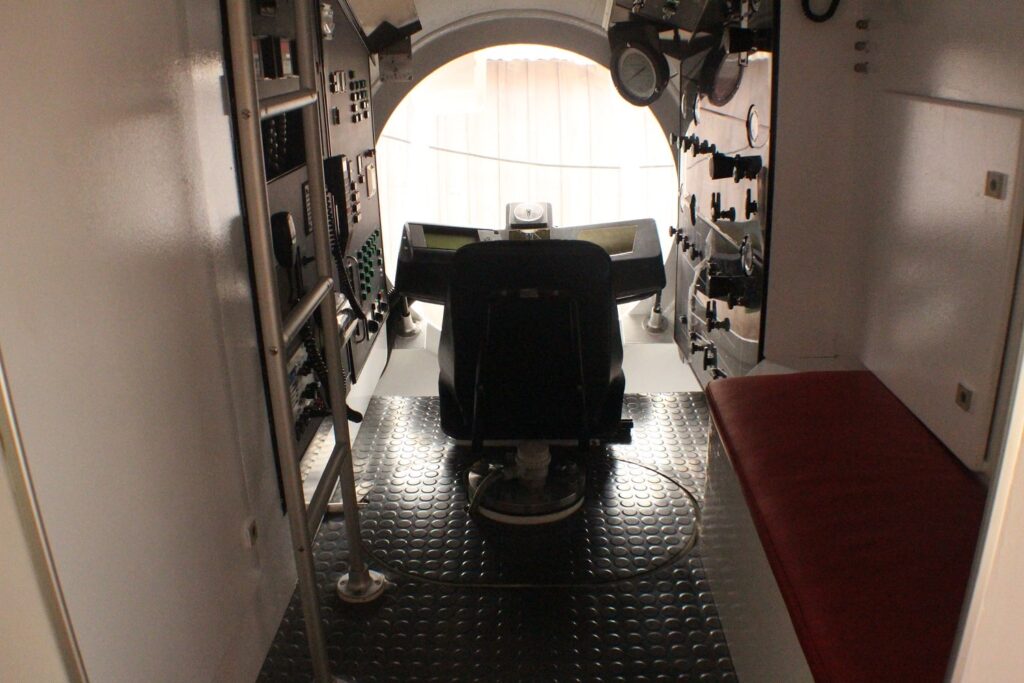LIFE SUPPORT AND ENVIRONMENTAL CONTROL SYSTEMS
The life support system consists of oxygen, carbon dioxide removal, and air conditioning systems. The oxygen system maintains the internal oxygen level at 21% throughout the dive. There are two onboard oxygen systems (main and reserve), which will support 26 persons for a minimum of 72 hours in emergency situations.
The carbon dioxide is removed with six independent scrubber units. The scrubbers are filled with carbon dioxide removal absorbent (soda lime) that will last for several dives depending on the number of passengers.
The levels of oxygen, carbon dioxide, and flammable gases are monitored continuously with electronic gas analyzers. Any high or low-level concentration is indicated with an audible and visible alarm.
The temperature and humidity are controlled with an air conditioning system based on compressor circulated Freon heat exchangers. The unit is located in the engine room. The cooled air is circulated in the compartments with blowers and ducting.
The hydrogen purge system is located in the pilot compartment. The blowers create suction from the battery compartment and blow air through catalyzing units back to the compartment removing thus any hydrogen from battery spaces.
COMMUNICATIONS
The submarine remains in constant contact with the surface operaations controller when dived, by use of the underwater telephone (UWT). When on the surface communication is by use of a marine VHF radio.
ALARM AND MONITORING SYSTEMS
The alarm panel incorporates battery monitoring and centralized alarm systems. Both 248V and 24V battery systems are monitored continuously. In the case of the low battery voltage, an audible and visible alarm is given.
The insulation resistance (IR) system is monitoring power supply routes and measuring any currents that might be leaking to the submarine hull. In the case of fault, an audible and visible alarm is given.
The bilge water level is monitored with a sensor situated at the end of each bilge suction line. In the case of water ingress, a visible alarm is given at the control panel.
EMERGENCY SYSTEMS
For emergency use, a carbon dioxide removal absorbent reserve is stored onboard. This absorbent will be used in the scrubbers and it is sufficient for 72 hrs of scrubbing with a maximum number of passengers on board. During an emergency, the scrubbers will take their energy from the emergency batteries if necessary.
All passengers are provided with individual emergency breathing systems. The system capacity is sufficient to enable the submarine to surface from its maximum operating depth and in a safe manner unload the submarine.
The jettisonable drop weight is provided to be released in the case of an emergency. The drop weight is located underneath the submarine. The weight release is activated by an independent hydraulic circuit. The drop weight can be released or locked with a selector valve and hydraulic hand pump.
The firefighting system is divided into passive and active firefighting systems. Passive firefighting is carried out during the design. Electrical cables and interior materials are selected according to the rules and regulations of classification societies. The fire retardant materials will not maintain a fire. The active system is divided into hand extinguishers, a fixed inert gas system, and an alarm system. All firefighting systems are based on inert gas, positioned in the bow of the submarine, battery compartments, and aft equipment room. These systems can be activated by the pilot. The fire detection sensors are located in the passenger compartment, in the battery purge line, and in the engine room. The sensors will activate the alarm system giving an indication of the location of the fire.
The 24 Volt batteries are divided into emergency and main batteries. In case of a power failure, the emergency batteries will be connected automatically. The 24 V power distributions are divided into essential and nonessential users. When the emergency power is connected on the preselected essential users are coupled on and the rest of the users are turned off. The power distribution is also equipped with a manual override switch. If the pilot wants to use non-essential users during the power failure he can provide these users with energy by means of using the manual override. The emergency power will disconnect automatically when normal power becomes available.
Special instruments are provided to locate the submarine under surface. The primary device is the surface buoy. The Xenon flasher unit is used to give a visual aid to locate the submarine on the surface or submerged. The surface visibility is up to 10 miles. The battery-powered unit is located on the mast frame and switched on from the pilot control panel.
Standard approved life jackets are fitted to fast release holders above the passenger seats, together with emergency breathing units (BIBS).

